Shifting Australia's Population: Preparing for Climate Change Impacts
VerifiedAdded on 2023/01/18
|9
|2555
|32
Essay
AI Summary
This essay examines the imperative shift in Australia's population distribution in response to the escalating impacts of climate change, with a specific focus on the increasing threat of bushfires. It highlights how Australia's already hot and dry climate is worsening, leading to more frequent and intense heatwaves, droughts, and wildfires. The essay details the detrimental effects of these climate change-induced disasters, including health complications, respiratory problems from air pollution, and increased vulnerability to other weather extremes like mudslides and floods. It further discusses the economic impacts, such as the degradation of infrastructure and the challenges faced by the agricultural sector. The essay concludes by emphasizing the need for proactive measures, including government initiatives for fire prevention and community education, as well as the potential for managed migration and relocation of industries to less affected areas. The Australian government needs to equip itself with knowledge on the nature and severity of impacts of climate change at regional and community levels. Desklib offers a platform to explore similar essays and study resources for students.
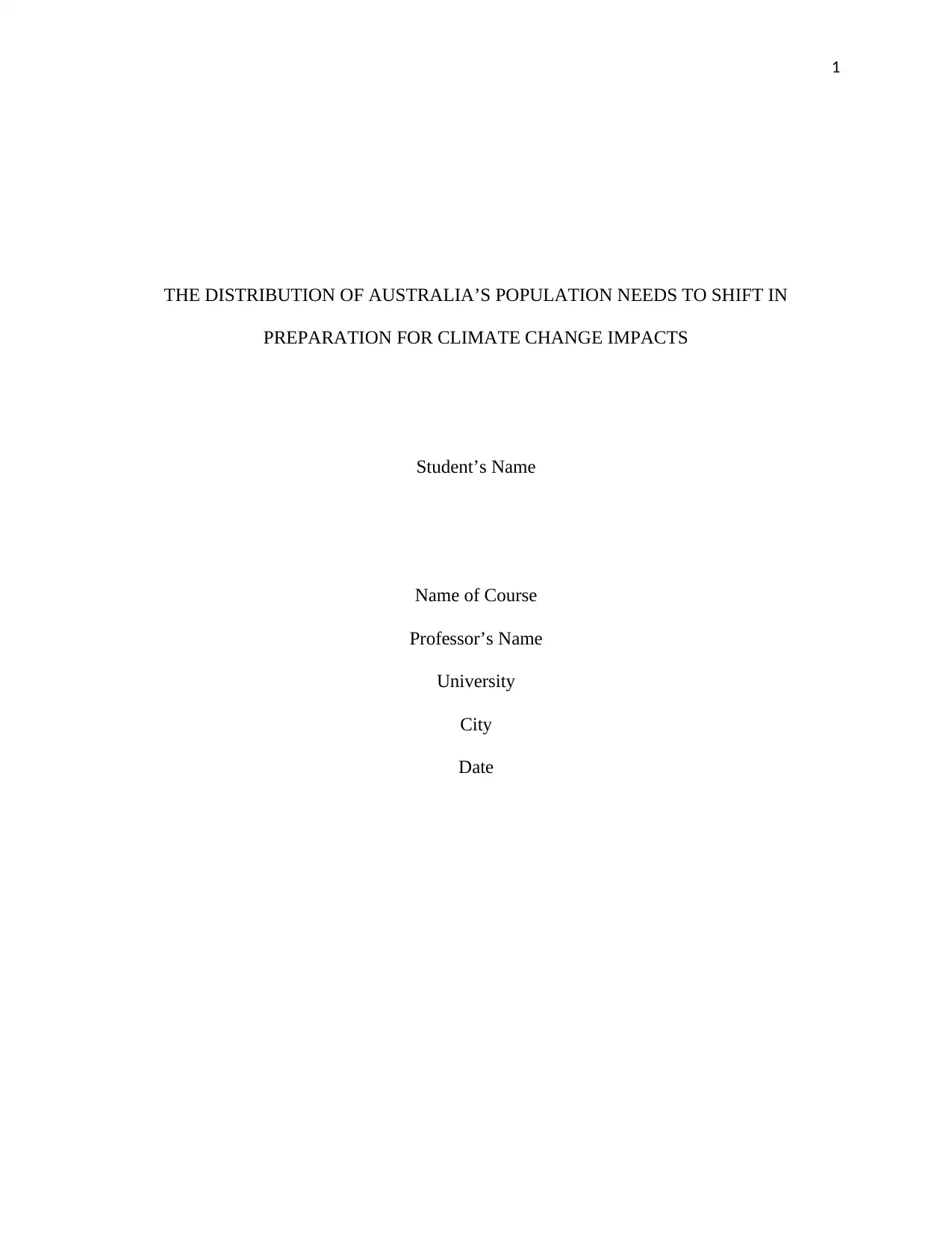
1
THE DISTRIBUTION OF AUSTRALIA’S POPULATION NEEDS TO SHIFT IN
PREPARATION FOR CLIMATE CHANGE IMPACTS
Student’s Name
Name of Course
Professor’s Name
University
City
Date
THE DISTRIBUTION OF AUSTRALIA’S POPULATION NEEDS TO SHIFT IN
PREPARATION FOR CLIMATE CHANGE IMPACTS
Student’s Name
Name of Course
Professor’s Name
University
City
Date
Paraphrase This Document
Need a fresh take? Get an instant paraphrase of this document with our AI Paraphraser
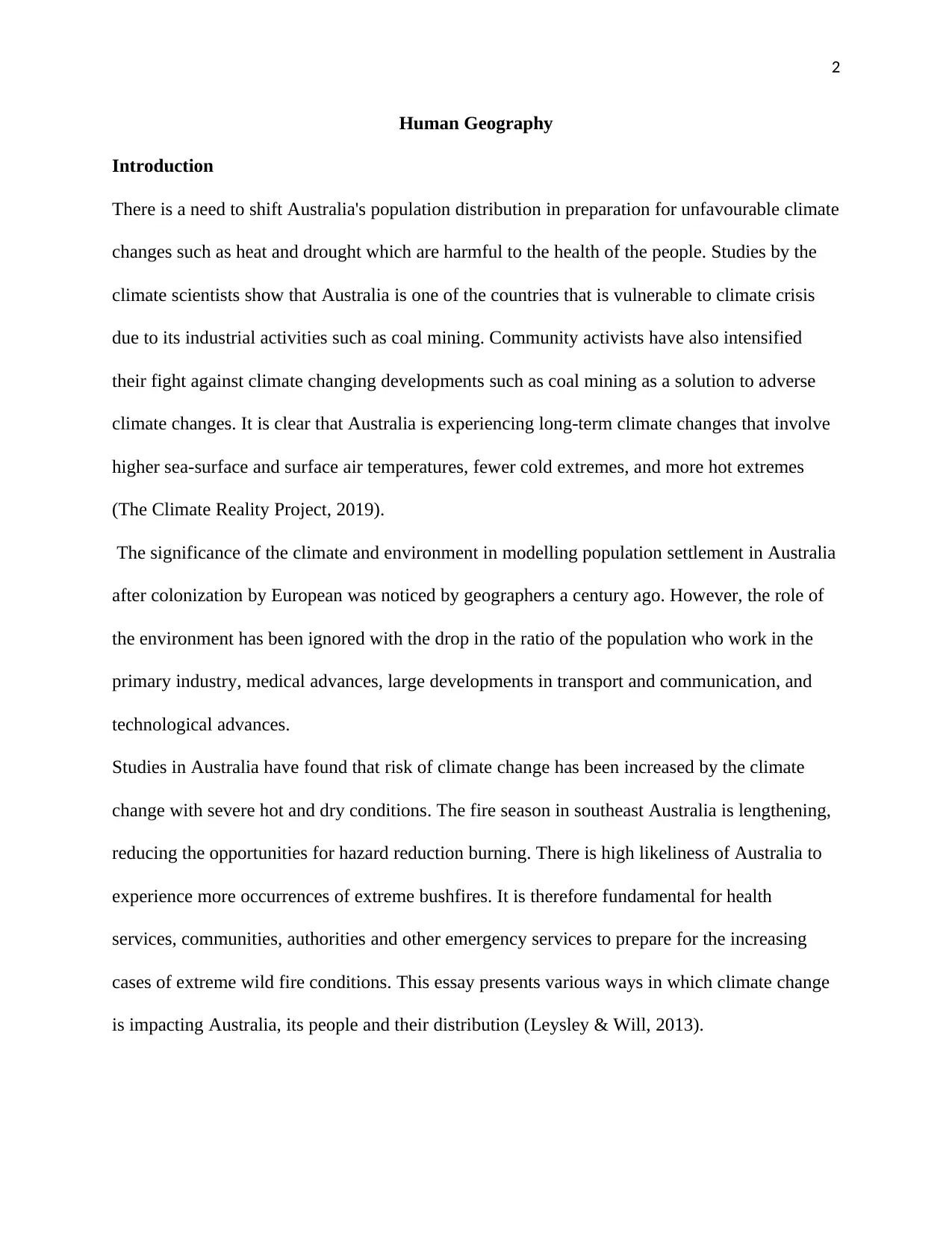
2
Human Geography
Introduction
There is a need to shift Australia's population distribution in preparation for unfavourable climate
changes such as heat and drought which are harmful to the health of the people. Studies by the
climate scientists show that Australia is one of the countries that is vulnerable to climate crisis
due to its industrial activities such as coal mining. Community activists have also intensified
their fight against climate changing developments such as coal mining as a solution to adverse
climate changes. It is clear that Australia is experiencing long-term climate changes that involve
higher sea-surface and surface air temperatures, fewer cold extremes, and more hot extremes
(The Climate Reality Project, 2019).
The significance of the climate and environment in modelling population settlement in Australia
after colonization by European was noticed by geographers a century ago. However, the role of
the environment has been ignored with the drop in the ratio of the population who work in the
primary industry, medical advances, large developments in transport and communication, and
technological advances.
Studies in Australia have found that risk of climate change has been increased by the climate
change with severe hot and dry conditions. The fire season in southeast Australia is lengthening,
reducing the opportunities for hazard reduction burning. There is high likeliness of Australia to
experience more occurrences of extreme bushfires. It is therefore fundamental for health
services, communities, authorities and other emergency services to prepare for the increasing
cases of extreme wild fire conditions. This essay presents various ways in which climate change
is impacting Australia, its people and their distribution (Leysley & Will, 2013).
Human Geography
Introduction
There is a need to shift Australia's population distribution in preparation for unfavourable climate
changes such as heat and drought which are harmful to the health of the people. Studies by the
climate scientists show that Australia is one of the countries that is vulnerable to climate crisis
due to its industrial activities such as coal mining. Community activists have also intensified
their fight against climate changing developments such as coal mining as a solution to adverse
climate changes. It is clear that Australia is experiencing long-term climate changes that involve
higher sea-surface and surface air temperatures, fewer cold extremes, and more hot extremes
(The Climate Reality Project, 2019).
The significance of the climate and environment in modelling population settlement in Australia
after colonization by European was noticed by geographers a century ago. However, the role of
the environment has been ignored with the drop in the ratio of the population who work in the
primary industry, medical advances, large developments in transport and communication, and
technological advances.
Studies in Australia have found that risk of climate change has been increased by the climate
change with severe hot and dry conditions. The fire season in southeast Australia is lengthening,
reducing the opportunities for hazard reduction burning. There is high likeliness of Australia to
experience more occurrences of extreme bushfires. It is therefore fundamental for health
services, communities, authorities and other emergency services to prepare for the increasing
cases of extreme wild fire conditions. This essay presents various ways in which climate change
is impacting Australia, its people and their distribution (Leysley & Will, 2013).
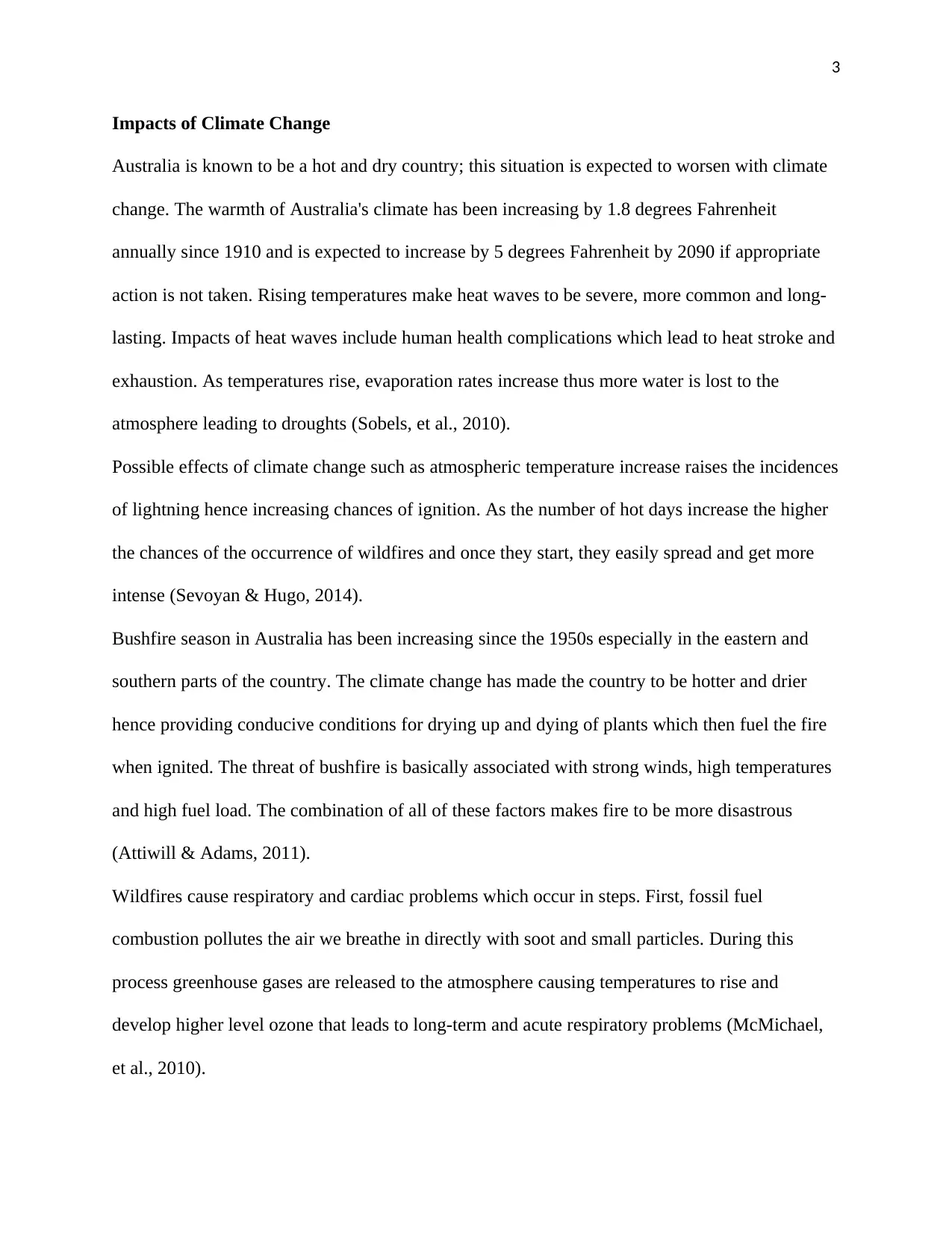
3
Impacts of Climate Change
Australia is known to be a hot and dry country; this situation is expected to worsen with climate
change. The warmth of Australia's climate has been increasing by 1.8 degrees Fahrenheit
annually since 1910 and is expected to increase by 5 degrees Fahrenheit by 2090 if appropriate
action is not taken. Rising temperatures make heat waves to be severe, more common and long-
lasting. Impacts of heat waves include human health complications which lead to heat stroke and
exhaustion. As temperatures rise, evaporation rates increase thus more water is lost to the
atmosphere leading to droughts (Sobels, et al., 2010).
Possible effects of climate change such as atmospheric temperature increase raises the incidences
of lightning hence increasing chances of ignition. As the number of hot days increase the higher
the chances of the occurrence of wildfires and once they start, they easily spread and get more
intense (Sevoyan & Hugo, 2014).
Bushfire season in Australia has been increasing since the 1950s especially in the eastern and
southern parts of the country. The climate change has made the country to be hotter and drier
hence providing conducive conditions for drying up and dying of plants which then fuel the fire
when ignited. The threat of bushfire is basically associated with strong winds, high temperatures
and high fuel load. The combination of all of these factors makes fire to be more disastrous
(Attiwill & Adams, 2011).
Wildfires cause respiratory and cardiac problems which occur in steps. First, fossil fuel
combustion pollutes the air we breathe in directly with soot and small particles. During this
process greenhouse gases are released to the atmosphere causing temperatures to rise and
develop higher level ozone that leads to long-term and acute respiratory problems (McMichael,
et al., 2010).
Impacts of Climate Change
Australia is known to be a hot and dry country; this situation is expected to worsen with climate
change. The warmth of Australia's climate has been increasing by 1.8 degrees Fahrenheit
annually since 1910 and is expected to increase by 5 degrees Fahrenheit by 2090 if appropriate
action is not taken. Rising temperatures make heat waves to be severe, more common and long-
lasting. Impacts of heat waves include human health complications which lead to heat stroke and
exhaustion. As temperatures rise, evaporation rates increase thus more water is lost to the
atmosphere leading to droughts (Sobels, et al., 2010).
Possible effects of climate change such as atmospheric temperature increase raises the incidences
of lightning hence increasing chances of ignition. As the number of hot days increase the higher
the chances of the occurrence of wildfires and once they start, they easily spread and get more
intense (Sevoyan & Hugo, 2014).
Bushfire season in Australia has been increasing since the 1950s especially in the eastern and
southern parts of the country. The climate change has made the country to be hotter and drier
hence providing conducive conditions for drying up and dying of plants which then fuel the fire
when ignited. The threat of bushfire is basically associated with strong winds, high temperatures
and high fuel load. The combination of all of these factors makes fire to be more disastrous
(Attiwill & Adams, 2011).
Wildfires cause respiratory and cardiac problems which occur in steps. First, fossil fuel
combustion pollutes the air we breathe in directly with soot and small particles. During this
process greenhouse gases are released to the atmosphere causing temperatures to rise and
develop higher level ozone that leads to long-term and acute respiratory problems (McMichael,
et al., 2010).
⊘ This is a preview!⊘
Do you want full access?
Subscribe today to unlock all pages.

Trusted by 1+ million students worldwide
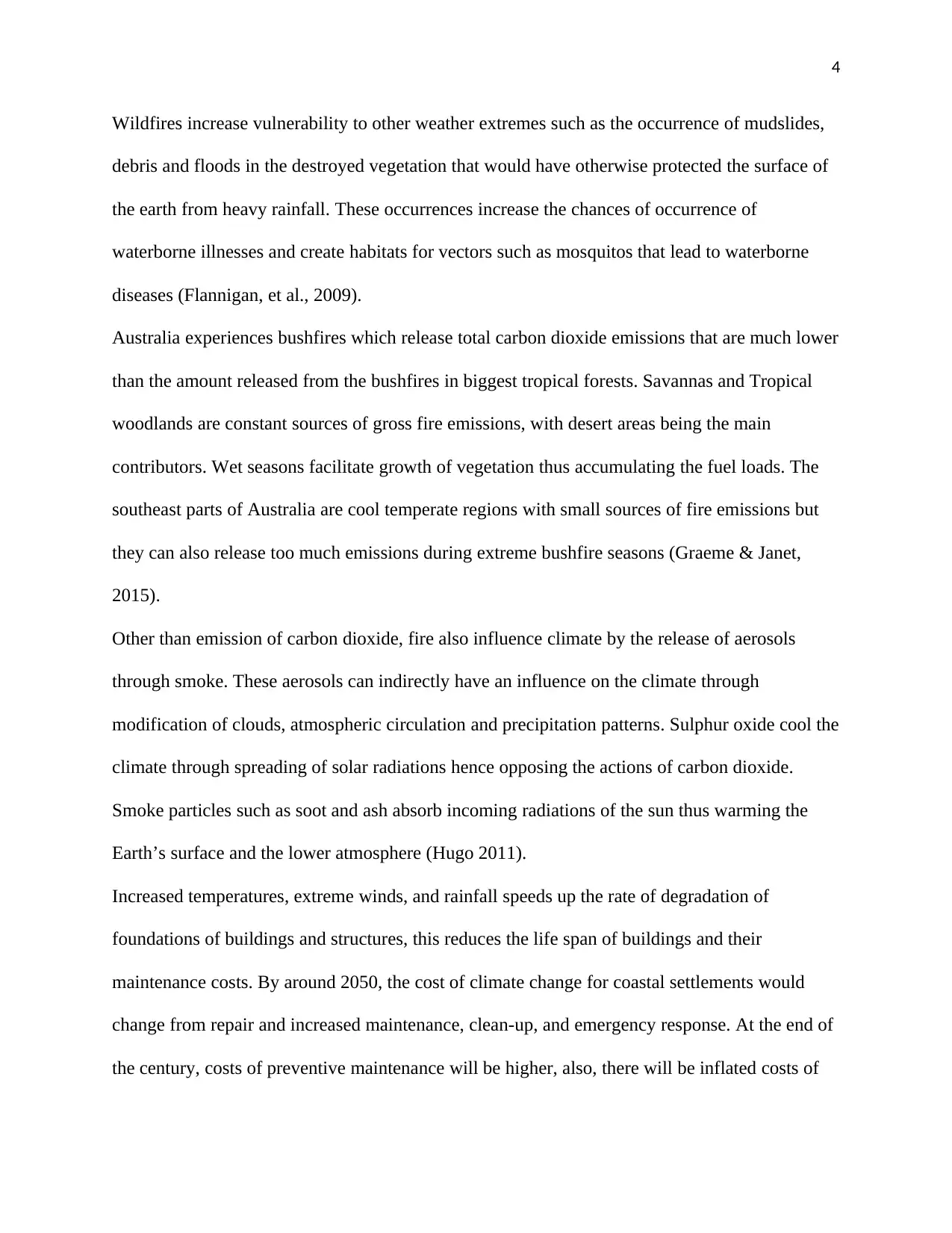
4
Wildfires increase vulnerability to other weather extremes such as the occurrence of mudslides,
debris and floods in the destroyed vegetation that would have otherwise protected the surface of
the earth from heavy rainfall. These occurrences increase the chances of occurrence of
waterborne illnesses and create habitats for vectors such as mosquitos that lead to waterborne
diseases (Flannigan, et al., 2009).
Australia experiences bushfires which release total carbon dioxide emissions that are much lower
than the amount released from the bushfires in biggest tropical forests. Savannas and Tropical
woodlands are constant sources of gross fire emissions, with desert areas being the main
contributors. Wet seasons facilitate growth of vegetation thus accumulating the fuel loads. The
southeast parts of Australia are cool temperate regions with small sources of fire emissions but
they can also release too much emissions during extreme bushfire seasons (Graeme & Janet,
2015).
Other than emission of carbon dioxide, fire also influence climate by the release of aerosols
through smoke. These aerosols can indirectly have an influence on the climate through
modification of clouds, atmospheric circulation and precipitation patterns. Sulphur oxide cool the
climate through spreading of solar radiations hence opposing the actions of carbon dioxide.
Smoke particles such as soot and ash absorb incoming radiations of the sun thus warming the
Earth’s surface and the lower atmosphere (Hugo 2011).
Increased temperatures, extreme winds, and rainfall speeds up the rate of degradation of
foundations of buildings and structures, this reduces the life span of buildings and their
maintenance costs. By around 2050, the cost of climate change for coastal settlements would
change from repair and increased maintenance, clean-up, and emergency response. At the end of
the century, costs of preventive maintenance will be higher, also, there will be inflated costs of
Wildfires increase vulnerability to other weather extremes such as the occurrence of mudslides,
debris and floods in the destroyed vegetation that would have otherwise protected the surface of
the earth from heavy rainfall. These occurrences increase the chances of occurrence of
waterborne illnesses and create habitats for vectors such as mosquitos that lead to waterborne
diseases (Flannigan, et al., 2009).
Australia experiences bushfires which release total carbon dioxide emissions that are much lower
than the amount released from the bushfires in biggest tropical forests. Savannas and Tropical
woodlands are constant sources of gross fire emissions, with desert areas being the main
contributors. Wet seasons facilitate growth of vegetation thus accumulating the fuel loads. The
southeast parts of Australia are cool temperate regions with small sources of fire emissions but
they can also release too much emissions during extreme bushfire seasons (Graeme & Janet,
2015).
Other than emission of carbon dioxide, fire also influence climate by the release of aerosols
through smoke. These aerosols can indirectly have an influence on the climate through
modification of clouds, atmospheric circulation and precipitation patterns. Sulphur oxide cool the
climate through spreading of solar radiations hence opposing the actions of carbon dioxide.
Smoke particles such as soot and ash absorb incoming radiations of the sun thus warming the
Earth’s surface and the lower atmosphere (Hugo 2011).
Increased temperatures, extreme winds, and rainfall speeds up the rate of degradation of
foundations of buildings and structures, this reduces the life span of buildings and their
maintenance costs. By around 2050, the cost of climate change for coastal settlements would
change from repair and increased maintenance, clean-up, and emergency response. At the end of
the century, costs of preventive maintenance will be higher, also, there will be inflated costs of
Paraphrase This Document
Need a fresh take? Get an instant paraphrase of this document with our AI Paraphraser
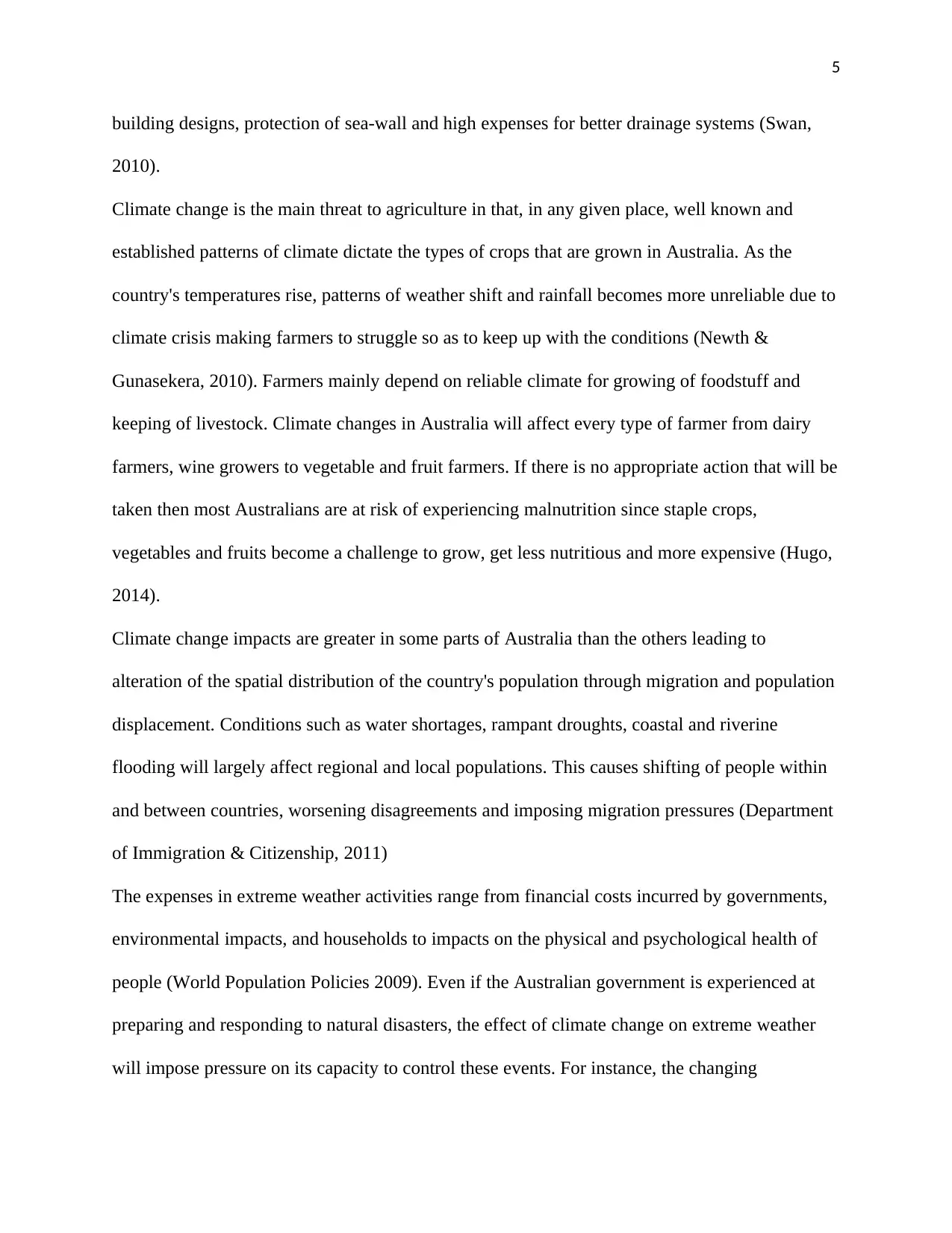
5
building designs, protection of sea-wall and high expenses for better drainage systems (Swan,
2010).
Climate change is the main threat to agriculture in that, in any given place, well known and
established patterns of climate dictate the types of crops that are grown in Australia. As the
country's temperatures rise, patterns of weather shift and rainfall becomes more unreliable due to
climate crisis making farmers to struggle so as to keep up with the conditions (Newth &
Gunasekera, 2010). Farmers mainly depend on reliable climate for growing of foodstuff and
keeping of livestock. Climate changes in Australia will affect every type of farmer from dairy
farmers, wine growers to vegetable and fruit farmers. If there is no appropriate action that will be
taken then most Australians are at risk of experiencing malnutrition since staple crops,
vegetables and fruits become a challenge to grow, get less nutritious and more expensive (Hugo,
2014).
Climate change impacts are greater in some parts of Australia than the others leading to
alteration of the spatial distribution of the country's population through migration and population
displacement. Conditions such as water shortages, rampant droughts, coastal and riverine
flooding will largely affect regional and local populations. This causes shifting of people within
and between countries, worsening disagreements and imposing migration pressures (Department
of Immigration & Citizenship, 2011)
The expenses in extreme weather activities range from financial costs incurred by governments,
environmental impacts, and households to impacts on the physical and psychological health of
people (World Population Policies 2009). Even if the Australian government is experienced at
preparing and responding to natural disasters, the effect of climate change on extreme weather
will impose pressure on its capacity to control these events. For instance, the changing
building designs, protection of sea-wall and high expenses for better drainage systems (Swan,
2010).
Climate change is the main threat to agriculture in that, in any given place, well known and
established patterns of climate dictate the types of crops that are grown in Australia. As the
country's temperatures rise, patterns of weather shift and rainfall becomes more unreliable due to
climate crisis making farmers to struggle so as to keep up with the conditions (Newth &
Gunasekera, 2010). Farmers mainly depend on reliable climate for growing of foodstuff and
keeping of livestock. Climate changes in Australia will affect every type of farmer from dairy
farmers, wine growers to vegetable and fruit farmers. If there is no appropriate action that will be
taken then most Australians are at risk of experiencing malnutrition since staple crops,
vegetables and fruits become a challenge to grow, get less nutritious and more expensive (Hugo,
2014).
Climate change impacts are greater in some parts of Australia than the others leading to
alteration of the spatial distribution of the country's population through migration and population
displacement. Conditions such as water shortages, rampant droughts, coastal and riverine
flooding will largely affect regional and local populations. This causes shifting of people within
and between countries, worsening disagreements and imposing migration pressures (Department
of Immigration & Citizenship, 2011)
The expenses in extreme weather activities range from financial costs incurred by governments,
environmental impacts, and households to impacts on the physical and psychological health of
people (World Population Policies 2009). Even if the Australian government is experienced at
preparing and responding to natural disasters, the effect of climate change on extreme weather
will impose pressure on its capacity to control these events. For instance, the changing
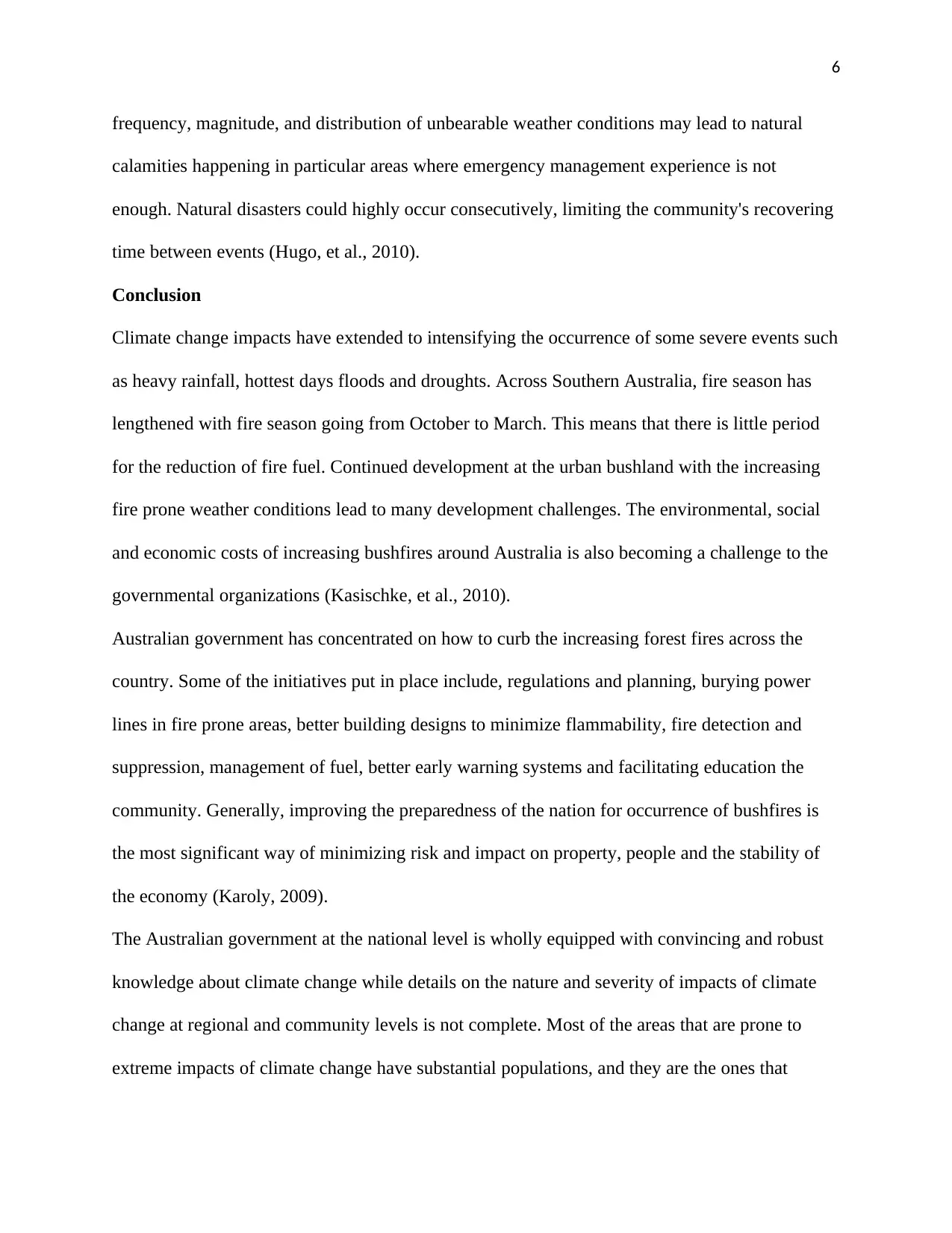
6
frequency, magnitude, and distribution of unbearable weather conditions may lead to natural
calamities happening in particular areas where emergency management experience is not
enough. Natural disasters could highly occur consecutively, limiting the community's recovering
time between events (Hugo, et al., 2010).
Conclusion
Climate change impacts have extended to intensifying the occurrence of some severe events such
as heavy rainfall, hottest days floods and droughts. Across Southern Australia, fire season has
lengthened with fire season going from October to March. This means that there is little period
for the reduction of fire fuel. Continued development at the urban bushland with the increasing
fire prone weather conditions lead to many development challenges. The environmental, social
and economic costs of increasing bushfires around Australia is also becoming a challenge to the
governmental organizations (Kasischke, et al., 2010).
Australian government has concentrated on how to curb the increasing forest fires across the
country. Some of the initiatives put in place include, regulations and planning, burying power
lines in fire prone areas, better building designs to minimize flammability, fire detection and
suppression, management of fuel, better early warning systems and facilitating education the
community. Generally, improving the preparedness of the nation for occurrence of bushfires is
the most significant way of minimizing risk and impact on property, people and the stability of
the economy (Karoly, 2009).
The Australian government at the national level is wholly equipped with convincing and robust
knowledge about climate change while details on the nature and severity of impacts of climate
change at regional and community levels is not complete. Most of the areas that are prone to
extreme impacts of climate change have substantial populations, and they are the ones that
frequency, magnitude, and distribution of unbearable weather conditions may lead to natural
calamities happening in particular areas where emergency management experience is not
enough. Natural disasters could highly occur consecutively, limiting the community's recovering
time between events (Hugo, et al., 2010).
Conclusion
Climate change impacts have extended to intensifying the occurrence of some severe events such
as heavy rainfall, hottest days floods and droughts. Across Southern Australia, fire season has
lengthened with fire season going from October to March. This means that there is little period
for the reduction of fire fuel. Continued development at the urban bushland with the increasing
fire prone weather conditions lead to many development challenges. The environmental, social
and economic costs of increasing bushfires around Australia is also becoming a challenge to the
governmental organizations (Kasischke, et al., 2010).
Australian government has concentrated on how to curb the increasing forest fires across the
country. Some of the initiatives put in place include, regulations and planning, burying power
lines in fire prone areas, better building designs to minimize flammability, fire detection and
suppression, management of fuel, better early warning systems and facilitating education the
community. Generally, improving the preparedness of the nation for occurrence of bushfires is
the most significant way of minimizing risk and impact on property, people and the stability of
the economy (Karoly, 2009).
The Australian government at the national level is wholly equipped with convincing and robust
knowledge about climate change while details on the nature and severity of impacts of climate
change at regional and community levels is not complete. Most of the areas that are prone to
extreme impacts of climate change have substantial populations, and they are the ones that
⊘ This is a preview!⊘
Do you want full access?
Subscribe today to unlock all pages.

Trusted by 1+ million students worldwide
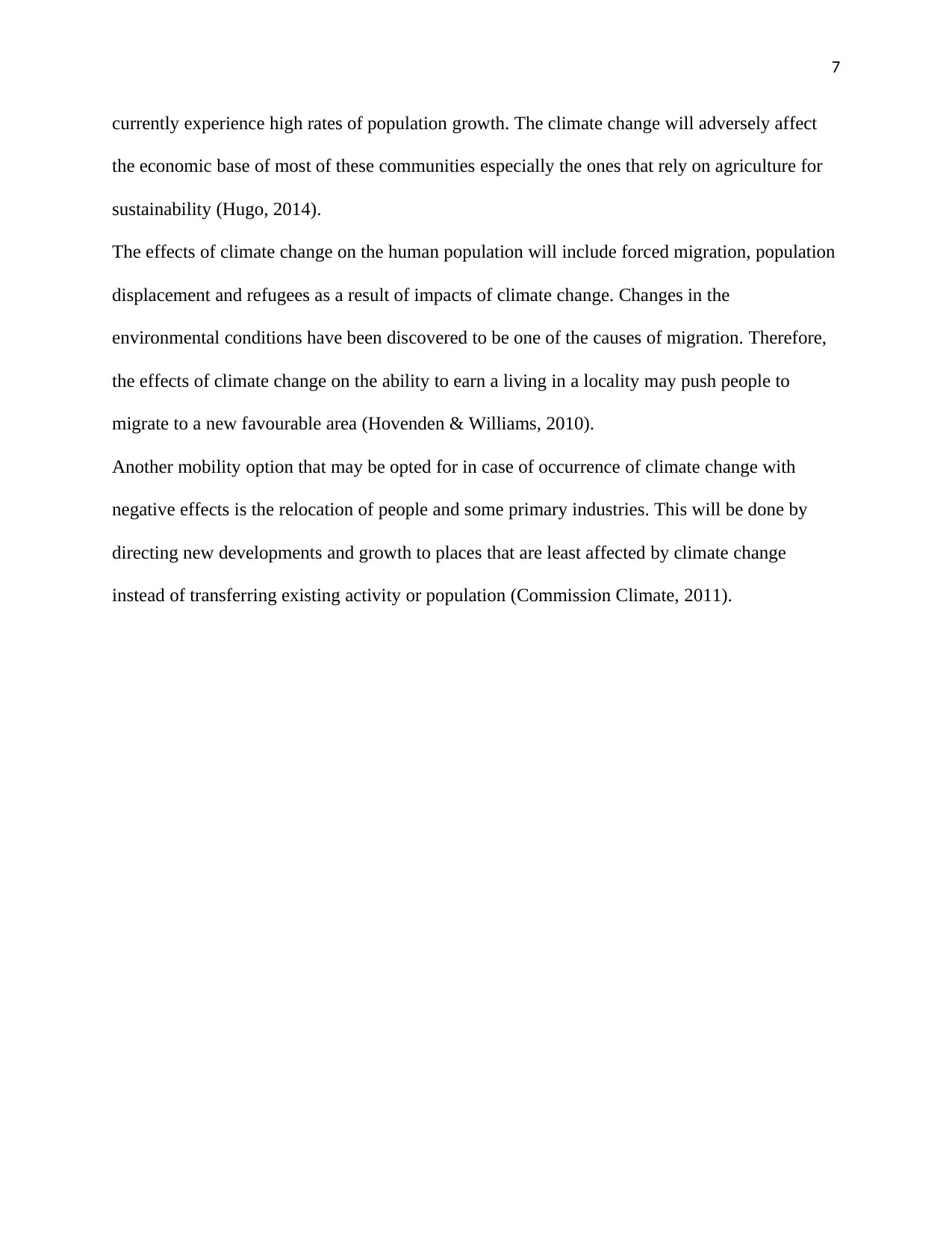
7
currently experience high rates of population growth. The climate change will adversely affect
the economic base of most of these communities especially the ones that rely on agriculture for
sustainability (Hugo, 2014).
The effects of climate change on the human population will include forced migration, population
displacement and refugees as a result of impacts of climate change. Changes in the
environmental conditions have been discovered to be one of the causes of migration. Therefore,
the effects of climate change on the ability to earn a living in a locality may push people to
migrate to a new favourable area (Hovenden & Williams, 2010).
Another mobility option that may be opted for in case of occurrence of climate change with
negative effects is the relocation of people and some primary industries. This will be done by
directing new developments and growth to places that are least affected by climate change
instead of transferring existing activity or population (Commission Climate, 2011).
currently experience high rates of population growth. The climate change will adversely affect
the economic base of most of these communities especially the ones that rely on agriculture for
sustainability (Hugo, 2014).
The effects of climate change on the human population will include forced migration, population
displacement and refugees as a result of impacts of climate change. Changes in the
environmental conditions have been discovered to be one of the causes of migration. Therefore,
the effects of climate change on the ability to earn a living in a locality may push people to
migrate to a new favourable area (Hovenden & Williams, 2010).
Another mobility option that may be opted for in case of occurrence of climate change with
negative effects is the relocation of people and some primary industries. This will be done by
directing new developments and growth to places that are least affected by climate change
instead of transferring existing activity or population (Commission Climate, 2011).
Paraphrase This Document
Need a fresh take? Get an instant paraphrase of this document with our AI Paraphraser
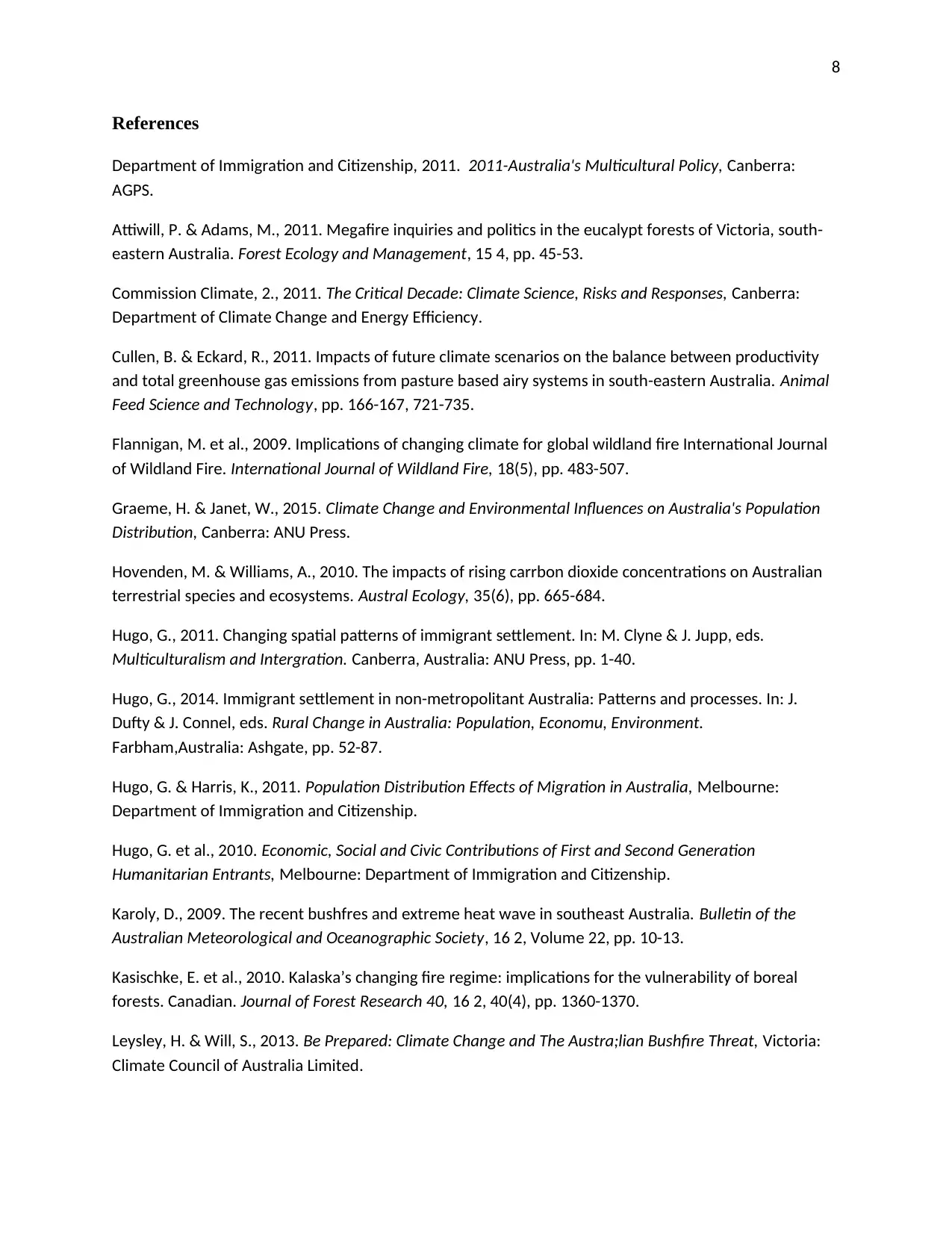
8
References
Department of Immigration and Citizenship, 2011. 2011-Australia's Multicultural Policy, Canberra:
AGPS.
Attiwill, P. & Adams, M., 2011. Megafire inquiries and politics in the eucalypt forests of Victoria, south-
eastern Australia. Forest Ecology and Management, 15 4, pp. 45-53.
Commission Climate, 2., 2011. The Critical Decade: Climate Science, Risks and Responses, Canberra:
Department of Climate Change and Energy Efficiency.
Cullen, B. & Eckard, R., 2011. Impacts of future climate scenarios on the balance between productivity
and total greenhouse gas emissions from pasture based airy systems in south-eastern Australia. Animal
Feed Science and Technology, pp. 166-167, 721-735.
Flannigan, M. et al., 2009. Implications of changing climate for global wildland fire International Journal
of Wildland Fire. International Journal of Wildland Fire, 18(5), pp. 483-507.
Graeme, H. & Janet, W., 2015. Climate Change and Environmental Influences on Australia's Population
Distribution, Canberra: ANU Press.
Hovenden, M. & Williams, A., 2010. The impacts of rising carrbon dioxide concentrations on Australian
terrestrial species and ecosystems. Austral Ecology, 35(6), pp. 665-684.
Hugo, G., 2011. Changing spatial patterns of immigrant settlement. In: M. Clyne & J. Jupp, eds.
Multiculturalism and Intergration. Canberra, Australia: ANU Press, pp. 1-40.
Hugo, G., 2014. Immigrant settlement in non-metropolitant Australia: Patterns and processes. In: J.
Dufty & J. Connel, eds. Rural Change in Australia: Population, Economu, Environment.
Farbham,Australia: Ashgate, pp. 52-87.
Hugo, G. & Harris, K., 2011. Population Distribution Effects of Migration in Australia, Melbourne:
Department of Immigration and Citizenship.
Hugo, G. et al., 2010. Economic, Social and Civic Contributions of First and Second Generation
Humanitarian Entrants, Melbourne: Department of Immigration and Citizenship.
Karoly, D., 2009. The recent bushfres and extreme heat wave in southeast Australia. Bulletin of the
Australian Meteorological and Oceanographic Society, 16 2, Volume 22, pp. 10-13.
Kasischke, E. et al., 2010. Kalaska’s changing fire regime: implications for the vulnerability of boreal
forests. Canadian. Journal of Forest Research 40, 16 2, 40(4), pp. 1360-1370.
Leysley, H. & Will, S., 2013. Be Prepared: Climate Change and The Austra;lian Bushfire Threat, Victoria:
Climate Council of Australia Limited.
References
Department of Immigration and Citizenship, 2011. 2011-Australia's Multicultural Policy, Canberra:
AGPS.
Attiwill, P. & Adams, M., 2011. Megafire inquiries and politics in the eucalypt forests of Victoria, south-
eastern Australia. Forest Ecology and Management, 15 4, pp. 45-53.
Commission Climate, 2., 2011. The Critical Decade: Climate Science, Risks and Responses, Canberra:
Department of Climate Change and Energy Efficiency.
Cullen, B. & Eckard, R., 2011. Impacts of future climate scenarios on the balance between productivity
and total greenhouse gas emissions from pasture based airy systems in south-eastern Australia. Animal
Feed Science and Technology, pp. 166-167, 721-735.
Flannigan, M. et al., 2009. Implications of changing climate for global wildland fire International Journal
of Wildland Fire. International Journal of Wildland Fire, 18(5), pp. 483-507.
Graeme, H. & Janet, W., 2015. Climate Change and Environmental Influences on Australia's Population
Distribution, Canberra: ANU Press.
Hovenden, M. & Williams, A., 2010. The impacts of rising carrbon dioxide concentrations on Australian
terrestrial species and ecosystems. Austral Ecology, 35(6), pp. 665-684.
Hugo, G., 2011. Changing spatial patterns of immigrant settlement. In: M. Clyne & J. Jupp, eds.
Multiculturalism and Intergration. Canberra, Australia: ANU Press, pp. 1-40.
Hugo, G., 2014. Immigrant settlement in non-metropolitant Australia: Patterns and processes. In: J.
Dufty & J. Connel, eds. Rural Change in Australia: Population, Economu, Environment.
Farbham,Australia: Ashgate, pp. 52-87.
Hugo, G. & Harris, K., 2011. Population Distribution Effects of Migration in Australia, Melbourne:
Department of Immigration and Citizenship.
Hugo, G. et al., 2010. Economic, Social and Civic Contributions of First and Second Generation
Humanitarian Entrants, Melbourne: Department of Immigration and Citizenship.
Karoly, D., 2009. The recent bushfres and extreme heat wave in southeast Australia. Bulletin of the
Australian Meteorological and Oceanographic Society, 16 2, Volume 22, pp. 10-13.
Kasischke, E. et al., 2010. Kalaska’s changing fire regime: implications for the vulnerability of boreal
forests. Canadian. Journal of Forest Research 40, 16 2, 40(4), pp. 1360-1370.
Leysley, H. & Will, S., 2013. Be Prepared: Climate Change and The Austra;lian Bushfire Threat, Victoria:
Climate Council of Australia Limited.
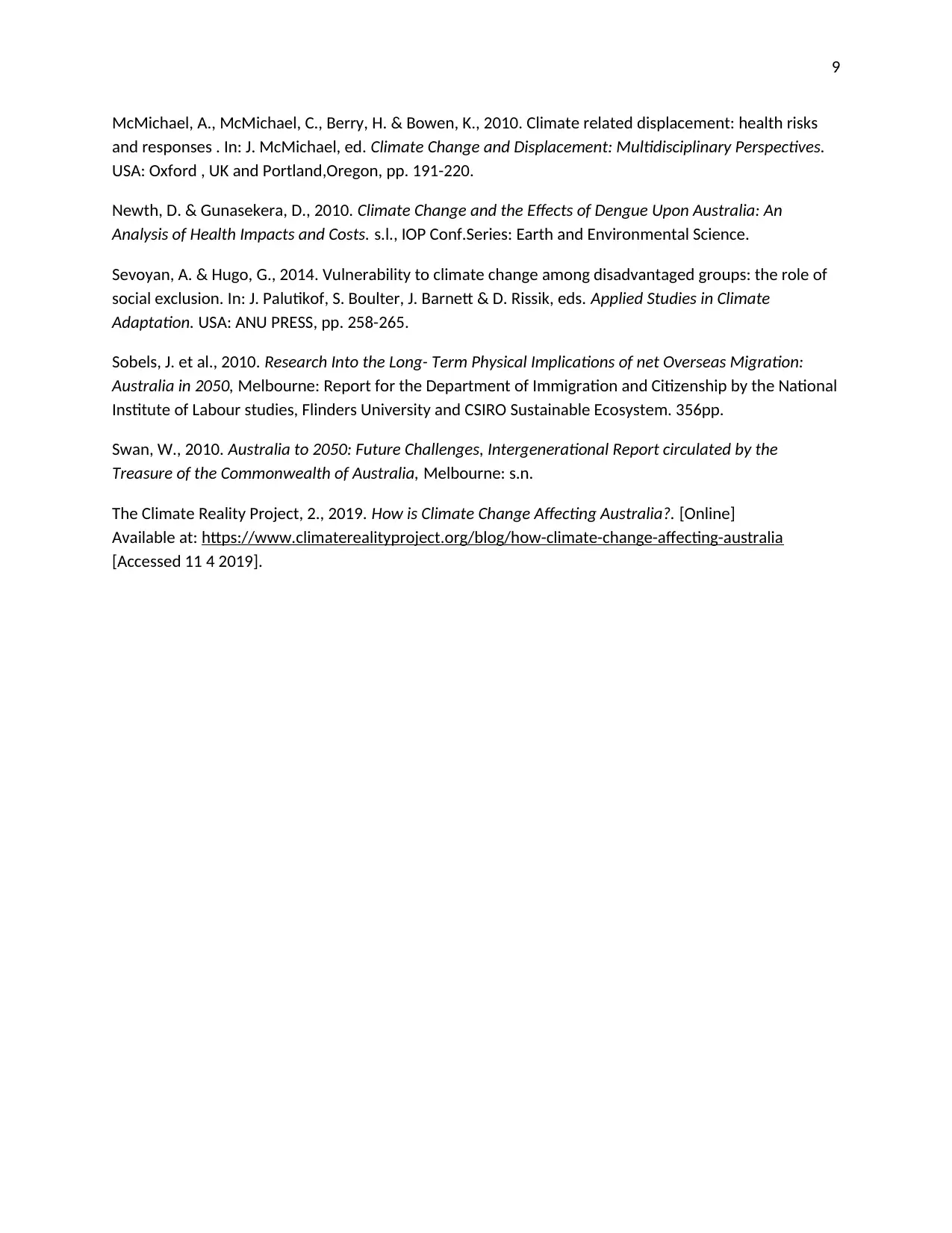
9
McMichael, A., McMichael, C., Berry, H. & Bowen, K., 2010. Climate related displacement: health risks
and responses . In: J. McMichael, ed. Climate Change and Displacement: Multidisciplinary Perspectives.
USA: Oxford , UK and Portland,Oregon, pp. 191-220.
Newth, D. & Gunasekera, D., 2010. Climate Change and the Effects of Dengue Upon Australia: An
Analysis of Health Impacts and Costs. s.l., IOP Conf.Series: Earth and Environmental Science.
Sevoyan, A. & Hugo, G., 2014. Vulnerability to climate change among disadvantaged groups: the role of
social exclusion. In: J. Palutikof, S. Boulter, J. Barnett & D. Rissik, eds. Applied Studies in Climate
Adaptation. USA: ANU PRESS, pp. 258-265.
Sobels, J. et al., 2010. Research Into the Long- Term Physical Implications of net Overseas Migration:
Australia in 2050, Melbourne: Report for the Department of Immigration and Citizenship by the National
Institute of Labour studies, Flinders University and CSIRO Sustainable Ecosystem. 356pp.
Swan, W., 2010. Australia to 2050: Future Challenges, Intergenerational Report circulated by the
Treasure of the Commonwealth of Australia, Melbourne: s.n.
The Climate Reality Project, 2., 2019. How is Climate Change Affecting Australia?. [Online]
Available at: https://www.climaterealityproject.org/blog/how-climate-change-affecting-australia
[Accessed 11 4 2019].
McMichael, A., McMichael, C., Berry, H. & Bowen, K., 2010. Climate related displacement: health risks
and responses . In: J. McMichael, ed. Climate Change and Displacement: Multidisciplinary Perspectives.
USA: Oxford , UK and Portland,Oregon, pp. 191-220.
Newth, D. & Gunasekera, D., 2010. Climate Change and the Effects of Dengue Upon Australia: An
Analysis of Health Impacts and Costs. s.l., IOP Conf.Series: Earth and Environmental Science.
Sevoyan, A. & Hugo, G., 2014. Vulnerability to climate change among disadvantaged groups: the role of
social exclusion. In: J. Palutikof, S. Boulter, J. Barnett & D. Rissik, eds. Applied Studies in Climate
Adaptation. USA: ANU PRESS, pp. 258-265.
Sobels, J. et al., 2010. Research Into the Long- Term Physical Implications of net Overseas Migration:
Australia in 2050, Melbourne: Report for the Department of Immigration and Citizenship by the National
Institute of Labour studies, Flinders University and CSIRO Sustainable Ecosystem. 356pp.
Swan, W., 2010. Australia to 2050: Future Challenges, Intergenerational Report circulated by the
Treasure of the Commonwealth of Australia, Melbourne: s.n.
The Climate Reality Project, 2., 2019. How is Climate Change Affecting Australia?. [Online]
Available at: https://www.climaterealityproject.org/blog/how-climate-change-affecting-australia
[Accessed 11 4 2019].
⊘ This is a preview!⊘
Do you want full access?
Subscribe today to unlock all pages.

Trusted by 1+ million students worldwide
1 out of 9
Related Documents
Your All-in-One AI-Powered Toolkit for Academic Success.
+13062052269
info@desklib.com
Available 24*7 on WhatsApp / Email
![[object Object]](/_next/static/media/star-bottom.7253800d.svg)
Unlock your academic potential
Copyright © 2020–2025 A2Z Services. All Rights Reserved. Developed and managed by ZUCOL.





